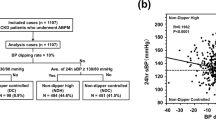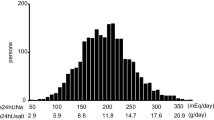Abstract
High salt-sensitivity and nondipper blood pressure (BP) rhythm are highly associated with each other, because both are caused by impaired renal sodium excretion capability. We proposed that nocturnal hypertension and resultant pressure natriuresis could compensate for daytime sodium retention. If so, high BP may continue until sodium is sufficiently excreted at night. In fact, it takes longer for the night-time BP to fall in patients with more severe renal dysfunction. The time appears to be an essential component of the nondipper BP rhythm and, therefore, we defined the duration as the dipping time. Also, renal function was the sole determinant of a nocturnal BP dip other than age, sex, or BMI. Furthermore, we reported that diuretic therapy or dietary salt restriction, which can prevent sodium retention, restored the circadian BP rhythm into a dipper pattern. Large-scale studies are needed to explore whether these interventions can decrease the risks.
Similar content being viewed by others
References
Recently published papers of particular interest have been highlighted as: • Of importance •• Of major importance
Kimura G. Sodium, kidney, and circadian rhythm of blood pressure. Clin Exp Nephrol. 2001;5:13–8.
Kimura G, Brenner BM. Implications of linear pressure-natriuresis relationship and importance of sodium sensitivity in hypertension. J Hypertens. 1997;15:1055–61.
Kimura G, Brenner BM. The renal basis for salt sensitivity in hypertension. In: Laragh JH, Brenner BM, editors. Hypertension pathophysiology, diagnosis, and management. 2nd ed. New York: Raven Press; 1995. p. 1569–88.
Dahl LK, Heine M, Tassinari L. Role of genetic factors in susceptibility to experimental hypertension due to chronic excess salt ingestion. Nature. 1962;194:480–2.
Dahl LK, Heine M. Primary role of renal homografts in setting chronic blood pressure levels in rats. Circ Res. 1975;36:692–6.
Kawasaki T, Delea CS, Bartter FC, Smith H. The effect of high sodium and low-sodium intakes on blood pressure and other related variables in human subjects with idiopathic hypertension. Am J Med. 1978;64:193–8.
Fujita T, Henry WL, Bartter FC, et al. Factors influencing blood pressure in salt-sensitive patients with hypertension. Am J Med. 1980;69:334–44.
Hollenberg NK, Moore T, Shoback D, et al. Abnormal renal sodium handling in essential hypertension. Relation to failure of renal and adrenal modulation of responses to angiotensin II. Am J Med. 1986;81:412–8.
Sullivan JM, Ratts TE. Sodium sensitivity in human subjects. Hemodynamic and hormonal correlates Hypertension. 1988;11(6 Pt 2):717–23.
Campese VM, Parise M, Karubian F, Bigazzi R. Abnormal renal hemodynamics in black salt-sensitive patients with hypertension. Hypertension. 1991;18:805–12.
Tuck M, Corry D, Trujillo A. Salt-sensitive blood pressure and exaggerated vascular reactivity in the hypertension of diabetes mellitus. Am J Med. 1990;88:210–6.
Guyton AC. Arterial pressure and hypertension. Circulatory physiology III. Philadelphia: WB Saunders; 1980.
Hall JE, Mizelle HL, Hildebrandt DA, Brands MW. Abnormal pressure natriuresis. A cause or a consequence of hypertension? Hypertension. 1990;15(6 Pt 1):547–59.
Tobian L, Lange J, Azar S. Reduction of natriuretic capacity and renin release in isolated, blood-perfused kidneys of Dahl hypertensive-prone rats. Circ Res. 1978;43(I):I-92–8.
Maddox DA, Bennett CM, Deen WM, et al. Determinants of glomerular filtration in experimental glomerulonephritis in the rat. J Clin Invest. 1975;55:305–18.
Baer PG, Bianchi G. Renal micropuncture study of normotensive and Milan hypertensive rats before and after development of hypertension. Kidney Int. 1978;13:452–66.
Deen WM, Maddox DA, Robertson CR, Brenner BM. Dynamics of glomerular ultrafiltration in the rat. VII. Response to reduced renal mass. Am J Physiol. 1974;227:556–62.
Hostetter TH, Olson JL, Rennke HG, et al. Hyperfiltration in remnant nephrons: a potentially adverse response to renal ablation. Am J Physiol. 1981;241:F85–93.
Dworkin LD, Hostetter TH, Rennke HG, Brenner BM. Hemodynamic basis for glomerular injury in rats with desoxycorticosterone-salt hypertension. J Clin Invest. 1984;73:1448–61.
Hostetter TH, Troy JL, Brenner BM. Glomerular hemodynamics in experimental diabetes mellitus. Kidney Int. 1981;19:410–5.
O’Donnell MP, Kasiske BL, Cleary MP, Keane WF. Effects of genetic obesity on renal structure and function in the Zucker rat. II. Micropuncture studies. J Lab Clin Med. 1985;106:605–10.
Fukuda M, Munemura M, Usami T, et al. Nocturnal blood pressure is elevated with natriuresis and proteinuria as renal function deteriorates in nephropathy. Kidney Int. 2004;65:621–5.
•• Fukuda M, Mizuno M, Yamanaka T. Patients with renal dysfunction require a longer duration until blood pressure dips during the night. Hypertension. 2008;52:1155–60. This paper demonstrates that, as a function of GFR loss, night-time high BP continues for a longer time.
Uzu T, Kimura G. Diuretics shift circadian rhythm of blood pressure from nondipper to dipper in essential hypertension. Circulation. 1999;100:1635–8.
Uzu T, Harada T, Namba T, et al. Thiazide diuretics enhance nocturnal blood pressure fall and reduce proteinuria in immunoglobulin A nephropathy treated with angiotensin II modulators. J Hypertens. 2005;23:861–5.
• Mu S, Shimosawa T, Ogura S. Epigenetic modulation of the renal β-adrenergic-WNK4 pathway in salt-sensitive hypertension. Nat Med. 2011;17:573–80. This paper focused on epigenetic modulation of WNK4 transcription in the development of salt-sensitive hypertension with sympathetic overactivity.
Sanada H, Yatabe J, Midorikawa S, et al. Single-nucleotide polymorphisms for diagnosis of salt-sensitive hypertension. Clin Chem. 2006;52:352–60.
O’Brien E, Sheridan J, O’Malley K. Dippers and nondippers. Lancet. 1988;II:397.
Verdecchia P, Schillaci G, Guerrieri M, et al. Circadian blood pressure changes and left ventricular hypertrophy in essential hypertension. Circulation. 1990;81:528–36.
Shimada K, Kawamoto A, Matsubayashi K, Ozawa T. Silent cerebrovascular disease in the elderly. Correlation with ambulatory pressure. Hypertension. 1990;16:692–9.
Pickering TG. The clinical significance of diurnal blood pressure variations. Dippers and nondippers. Circulation. 1990;81:700–2.
Verdecchia P, Schillaci G, Porcellati C. Dippers versus nondippers. J Hypertens. 1991;9 Suppl 8:S42–4.
Verdecchia P, Porcellati C, Schillaci G, et al. Ambulatory blood pressure. An independent predictor of prognosis in essential hypertension. Hypertension. 1994;24:793–801.
Bianchi S, Bigazzi R, Baldari G, et al. Diurnal variations of blood pressure and microalbuminuria in essential hypertension. Am J Hypertens. 1994;7:23–9.
Staessen JA, Thijs L, Fagard R, et al. Predicting cardiovascular risk using conventional vs ambulatory blood pressure in older patients with systolic hypertension. Systolic Hypertension in Europe Trial Investigators. JAMA. 1999;282:539–46.
Ingelsson E, Björklund-Bodegård K, Lind L, et al. Diurnal blood pressure pattern and risk of congestive heart failure. JAMA. 2006;295(28):2859–66.
Campese VM. Salt sensitivity in hypertension. Renal and cardiovascular implications. Hypertension. 1994;23:531–50.
Cappuccio FP, Strazzullo P, Siani A, Trevisan M. Increased proximal sodium reabsorption is associated with increased cardiovascular risk in men. J Hypertens. 1996;14:909–14.
Bigazzi R, Bianchi S, Baldari G, Campese VM. Clustering of cardiovascular risk factors in salt-sensitive patients with essential hypertension: role of insulin. Am J Hypertens. 1996;9:24–32.
Morimoto A, Uzu T, Fujii T, et al. Sodium sensitivity and cardiovascular events in patients with essential hypertension. Lancet. 1997;350:1734–7.
Whaley-Connell A, Sowers JR. Obesity, insulin resistance, and nocturnal systolic blood pressure. Hypertension. 2008;51:620–1.
Lurbe E, Torro I, Aguilar F, et al. Added impact of obesity and insulin resistance in nocturnal blood pressure elevation in children and adolescents. Hypertension. 2008;51:635–41.
Weinberger MH, Fineberg NS, Fineberg SE, Weinberger M. Salt sensitivity, pulse pressure, and death in normal and hypertensive humans. Hypertension. 2001;37(2):429–32. Part 2.
Luft FC, Miller JZ, Grim CE, et al. Salt sensitivity and resistance of blood pressure. Age and race as factors in physiological responses. Hypertension. 1991;17(I):I102–8.
Parmer RJ, Stone RA, Cervenka JH. Renal hemodynamics in essential hypertension. Racial differences in response to changes in dietary sodium. Hypertension. 1994;24:752–7.
Caplan LR. Strokes in African-Americans. Circulation. 1991;83:1469–71.
Broderick JP, Brott T, Tomsick T, et al. The risk of subarachnoid and intracerebral hemorrhages in blacks as compared with whites. N Engl J Med. 1992;326:733–6.
Mann JF, Gerstein HC, Pogue J, et al. Renal insufficiency as a predictor of cardiovascular outcomes and the impact of ramipril: the HOPE randomized trial. Ann Intern Med. 2001;134:629–36.
K/DOQI clinical practice guidelines for chronic kidney disease: evaluation, classification, and stratification. Am J Kidney Dis. 2002;39 (2 Suppl 1):S1–266.
Sarnak MJ, Levey AS, Schoolwerth AC, et al. Kidney disease as a risk factor for development of cardiovascular disease: a statement from the American Heart Association Councils on Kidney in Cardiovascular Disease, High Blood Pressure Research, Clinical Cardiology, and Epidemiology and Prevention. Circulation. 2003;108:2154–69.
Ritz E, McClellan WM. Overview: increased cardiovascular risk in patients with minor renal dysfunction: an emerging issue with far-reaching consequences. J Am Soc Nephrol. 2004;15:513–6.
Go AS, Chertow GM, Fan D, et al. Chronic kidney disease and the risks of death, cardiovascular events, and hospitalization. N Engl J Med. 2004;351:1296–305.
Uzu T, Ishikawa K, Fujii T, et al. Sodium restriction shifts circadian rhythm of blood pressure from nondipper to dipper in essential hypertension. Circulation. 1997;96:1859–62.
Lurbe E, Redon J, Kesani A, et al. Increase in nocturnal blood pressure and progression to microalbuminuria in type 1 diabetes. N Engl J Med. 2002;347:797–805.
García-Ortiz L, Gómez-Marcos MA, Martín-Moreiras J, et al. Pulse pressure and nocturnal fall in blood pressure are predictors of vascular, cardiac and renal target organ damage in hypertensive patients (LOD-RISK study). Blood Press Monit. 2009;14:145–51.
Davidson MB, Hix JK, Vidt DJ, Brotman DJ. Association of impaired diurnal blood pressure variation with a subsequent decline in glomerular filtration rate. Arch Intern Med. 2006;166:846–52.
Redon J, Plancha E, Swift PA, et al. Nocturnal blood pressure and progression to end-stage renal disease or death in nondiabetic chronic kidney disease stages 3 and 4. J Hypertens. 2010;28:602–7.
Torbjörnsdotter TB, Jaremko GA, Berg UB. Nondipping and its relation to glomerulopathy and hyperfiltration in adolescents with type 1 diabetes. Diabetes Care. 2004;27:510–6.
Disclosure
No potential conflicts of interest relevant to this article were reported.
Author information
Authors and Affiliations
Corresponding author
Rights and permissions
About this article
Cite this article
Fukuda, M., Kimura, G. Salt Sensitivity and Nondippers in Chronic Kidney Disease. Curr Hypertens Rep 14, 382–387 (2012). https://doi.org/10.1007/s11906-012-0286-3
Published:
Issue Date:
DOI: https://doi.org/10.1007/s11906-012-0286-3




